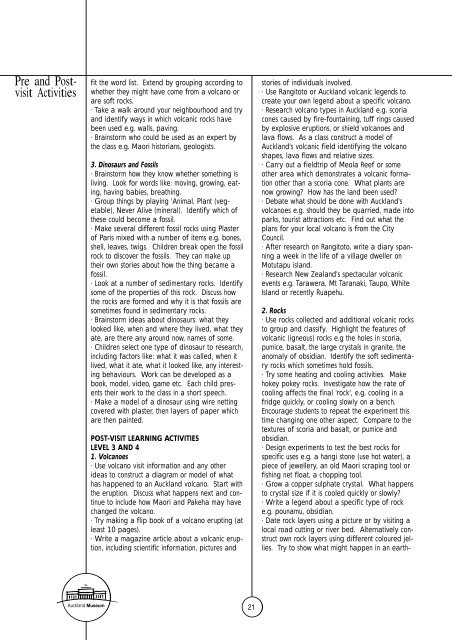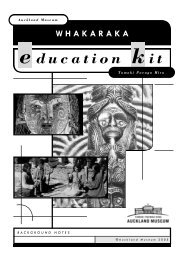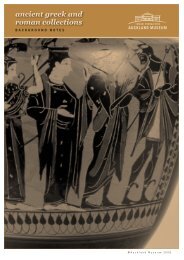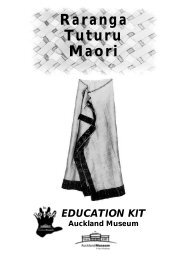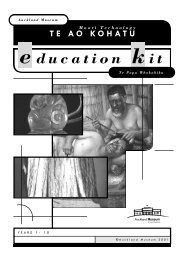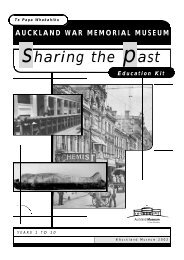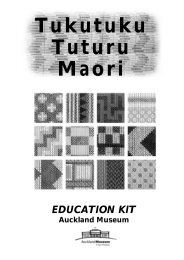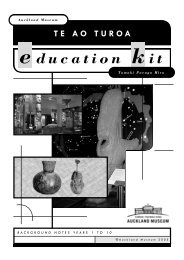Wanted: Oscar Obsidian - Auckland Museum
Wanted: Oscar Obsidian - Auckland Museum
Wanted: Oscar Obsidian - Auckland Museum
Create successful ePaper yourself
Turn your PDF publications into a flip-book with our unique Google optimized e-Paper software.
Pre and Postvisit<br />
Activities<br />
fit the word list. Extend by grouping according to<br />
whether they might have come from a volcano or<br />
are soft rocks.<br />
· Take a walk around your neighbourhood and try<br />
and identify ways in which volcanic rocks have<br />
been used e.g. walls, paving.<br />
· Brainstorm who could be used as an expert by<br />
the class e.g. Maori historians, geologists.<br />
3. Dinosaurs and Fossils<br />
· Brainstorm how they know whether something is<br />
living. Look for words like: moving, growing, eating,<br />
having babies, breathing.<br />
· Group things by playing 'Animal, Plant (vegetable),<br />
Never Alive (mineral). Identify which of<br />
these could become a fossil.<br />
· Make several different fossil rocks using Plaster<br />
of Paris mixed with a number of items e.g. bones,<br />
shell, leaves, twigs. Children break open the fossil<br />
rock to discover the fossils. They can make up<br />
their own stories about how the thing became a<br />
fossil.<br />
· Look at a number of sedimentary rocks. Identify<br />
some of the properties of this rock. Discuss how<br />
the rocks are formed and why it is that fossils are<br />
sometimes found in sedimentary rocks.<br />
· Brainstorm ideas about dinosaurs: what they<br />
looked like, when and where they lived, what they<br />
ate, are there any around now, names of some.<br />
· Children select one type of dinosaur to research,<br />
including factors like: what it was called, when it<br />
lived, what it ate, what it looked like, any interesting<br />
behaviours. Work can be developed as a<br />
book, model, video, game etc. Each child presents<br />
their work to the class in a short speech.<br />
· Make a model of a dinosaur using wire netting<br />
covered with plaster, then layers of paper which<br />
are then painted.<br />
POST-VISIT LEARNING ACTIVITIES<br />
LEVEL 3 AND 4<br />
1. Volcanoes<br />
· Use volcano visit information and any other<br />
ideas to construct a diagram or model of what<br />
has happened to an <strong>Auckland</strong> volcano. Start with<br />
the eruption. Discuss what happens next and continue<br />
to include how Maori and Pakeha may have<br />
changed the volcano.<br />
· Try making a flip book of a volcano erupting (at<br />
least 10 pages).<br />
· Write a magazine article about a volcanic eruption,<br />
including scientific information, pictures and<br />
<strong>Auckland</strong> <strong>Museum</strong> 21<br />
stories of individuals involved.<br />
· Use Rangitoto or <strong>Auckland</strong> volcanic legends to<br />
create your own legend about a specific volcano.<br />
· Research volcano types in <strong>Auckland</strong> e.g. scoria<br />
cones caused by fire-fountaining, tuff rings caused<br />
by explosive eruptions, or shield volcanoes and<br />
lava flows. As a class construct a model of<br />
<strong>Auckland</strong>'s volcanic field identifying the volcano<br />
shapes, lava flows and relative sizes.<br />
· Carry out a fieldtrip of Meola Reef or some<br />
other area which demonstrates a volcanic formation<br />
other than a scoria cone. What plants are<br />
now growing? How has the land been used?<br />
· Debate what should be done with <strong>Auckland</strong>'s<br />
volcanoes e.g. should they be quarried, made into<br />
parks, tourist attractions etc. Find out what the<br />
plans for your local volcano is from the City<br />
Council.<br />
· After research on Rangitoto, write a diary spanning<br />
a week in the life of a village dweller on<br />
Motutapu island.<br />
· Research New Zealand's spectacular volcanic<br />
events e.g. Tarawera, Mt Taranaki, Taupo, White<br />
Island or recently Ruapehu.<br />
2. Rocks<br />
· Use rocks collected and additional volcanic rocks<br />
to group and classify. Highlight the features of<br />
volcanic (igneous) rocks e.g the holes in scoria,<br />
pumice, basalt, the large crystals in granite, the<br />
anomaly of obsidian. Identify the soft sedimentary<br />
rocks which sometimes hold fossils.<br />
· Try some heating and cooling activities. Make<br />
hokey pokey rocks. Investigate how the rate of<br />
cooling affects the final 'rock', e.g. cooling in a<br />
fridge quickly, or cooling slowly on a bench.<br />
Encourage students to repeat the experiment this<br />
time changing one other aspect. Compare to the<br />
textures of scoria and basalt, or pumice and<br />
obsidian.<br />
· Design experiments to test the best rocks for<br />
specific uses e.g. a hangi stone (use hot water), a<br />
piece of jewellery, an old Maori scraping tool or<br />
fishing net float, a chopping tool.<br />
· Grow a copper sulphate crystal. What happens<br />
to crystal size if it is cooled quickly or slowly?<br />
· Write a legend about a specific type of rock<br />
e.g. pounamu, obsidian.<br />
· Date rock layers using a picture or by visiting a<br />
local road cutting or river bed. Alternatively construct<br />
own rock layers using different coloured jellies.<br />
Try to show what might happen in an earth-


